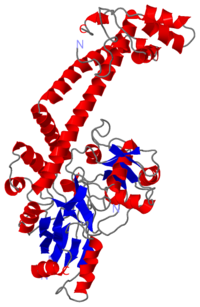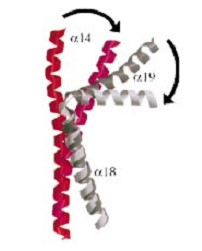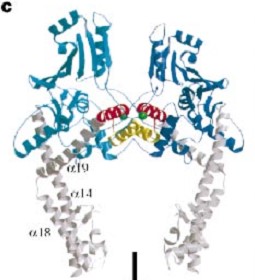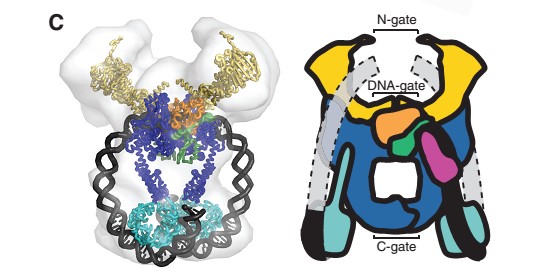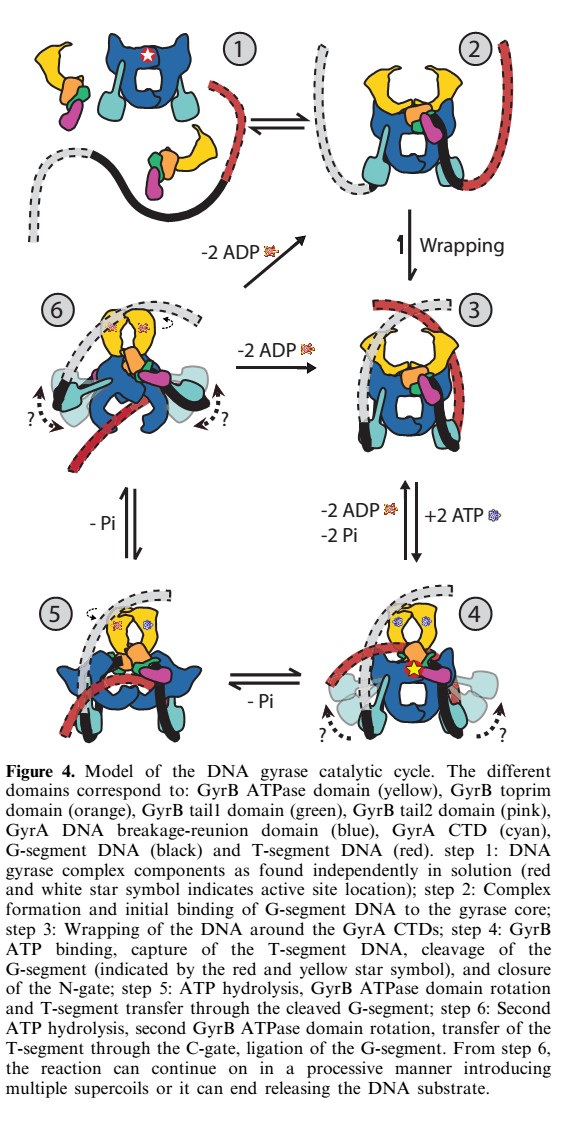Sandbox Reserved 828
From Proteopedia
(Difference between revisions)
| Line 10: | Line 10: | ||
| - | Gyrase is the '''only prokaryote DNA topoisomerase II able to introduce negative supercoils in the DNA''' (see [http://en.wikipedia.org/wiki/DNA_supercoil DNA Supercoil]) in order to remove positive supercoils. It '''catalyses the hydrolysis of two phosphodiester bonds in a DNA segment''' (called G segment). Then, thanks to '''ATP dependant conformation changes''' it enables the passage of another segment (the T segment) through the break, and then religates the broken segment. Gyrase acts prior to the replication (before the replication fork) or other mecanisms requiring loose DNA. | + | Gyrase is the '''only prokaryote DNA topoisomerase II able to introduce negative supercoils in the DNA''' (see [http://en.wikipedia.org/wiki/DNA_supercoil DNA Supercoil]) in order to remove positive supercoils. It '''catalyses the hydrolysis of two phosphodiester bonds in a DNA segment (DNA cleavage)''' (called G segment). Then, thanks to '''ATP dependant conformation changes''' it enables the passage of another segment (the T segment) through the break, and then religates the broken segment. Gyrase acts prior to the replication (before the replication fork) or other mecanisms requiring loose DNA. |
'''In abscence of ATP, like other topoisomerases II, gyrase only relaxes supercoils.''' | '''In abscence of ATP, like other topoisomerases II, gyrase only relaxes supercoils.''' | ||
| Line 72: | Line 72: | ||
=='''Reaction'''== | =='''Reaction'''== | ||
| + | |||
| + | The gyrase binds more strongly to relaxed or linear DNA than to supercoiled one by a factor of about ten. | ||
| + | |||
| + | |||
| + | |||
| + | |||
The cleavage of DNA is achieved by a '''transesterification reaction between the tyrosines (Tyr122) and the target phosphoryl groups on opposing strands of the DNA backbone''', resulting in the tyrosine being covalentlty attached to the 5' end of the cleaved segment with a 4-base overhang. | The cleavage of DNA is achieved by a '''transesterification reaction between the tyrosines (Tyr122) and the target phosphoryl groups on opposing strands of the DNA backbone''', resulting in the tyrosine being covalentlty attached to the 5' end of the cleaved segment with a 4-base overhang. | ||
The '''active site tyrosines (Tyr 122)''' are on loops at either end of the dimer interface, 30Å apart, and sit at the ends of strongly basic grooves created by the dimer-related monomers. | The '''active site tyrosines (Tyr 122)''' are on loops at either end of the dimer interface, 30Å apart, and sit at the ends of strongly basic grooves created by the dimer-related monomers. | ||
| Line 77: | Line 83: | ||
The gyrase structure reveals a '''new cluster of conserved residues''', juxtaposing Tyr 122 and Arg 121 from one monomer and His 80, Arg 32 and Lys 42 from the other monomer. '''This cluster may form the active site of the breakage–reunion reaction''', with the other conserved positive charges (Arg 46 and Arg 47) anchoring the non-covalently bound 3' end of the cleaved DNA. | The gyrase structure reveals a '''new cluster of conserved residues''', juxtaposing Tyr 122 and Arg 121 from one monomer and His 80, Arg 32 and Lys 42 from the other monomer. '''This cluster may form the active site of the breakage–reunion reaction''', with the other conserved positive charges (Arg 46 and Arg 47) anchoring the non-covalently bound 3' end of the cleaved DNA. | ||
| - | The | + | The A subunit is responsible for the breakage reunion of DNA whereas the B-subunit has the ATPase activity. |
| + | The introduction of negative supercoils requires the energy of ATP-hydrolysis. 2 ATP are hydrolyzed per reaction (2 B-subunits in the gyrase)so that the linking number (Lk) changes in step of 2. The ATPase activity of the B subunit is partially located in the N-terminal region of protein B whereas the C-terminal is involved in the interaction with the A subunit and DNA. | ||
| + | The B subunit has a weak ATPase activity in the absence of A and DNA, eventhought the A subunit is able to bind DNA without the B subunit. Both subunits are required for all the reactions of gyrase. | ||
The DNA supercoiling reaction requires in addition to ATP, a divalent cation such as Mg<sup>2+</sup>, and is stimulated in the presence of spermidine. | The DNA supercoiling reaction requires in addition to ATP, a divalent cation such as Mg<sup>2+</sup>, and is stimulated in the presence of spermidine. | ||
Therefore, the gyrase could also catalyse the following reaction : | Therefore, the gyrase could also catalyse the following reaction : | ||
| - | * | + | * Relaxation of negative/positive supercoils |
| + | * Catenation/Decatenation of closed-circular DNA | ||
| + | * DNA cleavage (induced by Quinolone) | ||
| + | * Unknotting DNA strands | ||
| + | Contrary to the introduction of negative supercoils, some of these reactions don't necessarily need the energy from ATP-hydrolysis. | ||
| + | The gyrase could be inhibited by both the quinolones and the coumarins. | ||
| + | Coumarins prevent the B-subunit of the gyrase from hydrolyzing the ATP, so that the gyrase can't come back to its starting state for another round of supercoiling. The mecanism is not yet well known. | ||
| + | The quinolones inhibit DNA supercoiling by gyrase, it has even the ability to induce DNA cleavage instead. It appears that these drugs will arrest any gyrase rection involving double-strand DNA breakage. | ||
| + | However, some mutations offers quinolone resistance, most of them involved a part of the GyrA sequence : between the amino acid 67 and 106. | ||
| + | There are also others antibiotics, like the Cinodine which binds DNA and inhibits its supercoiling by gyrase. | ||
| + | |||
| - | |||
==See Also== | ==See Also== | ||
*[[Gyrase|Gyrase]] | *[[Gyrase|Gyrase]] | ||
Revision as of 22:12, 29 December 2013
| This Sandbox is Reserved from 06/12/2018, through 30/06/2019 for use in the course "Structural Biology" taught by Bruno Kieffer at the University of Strasbourg, ESBS. This reservation includes Sandbox Reserved 1480 through Sandbox Reserved 1543. |
To get started:
More help: Help:Editing |
| |||||||||||
